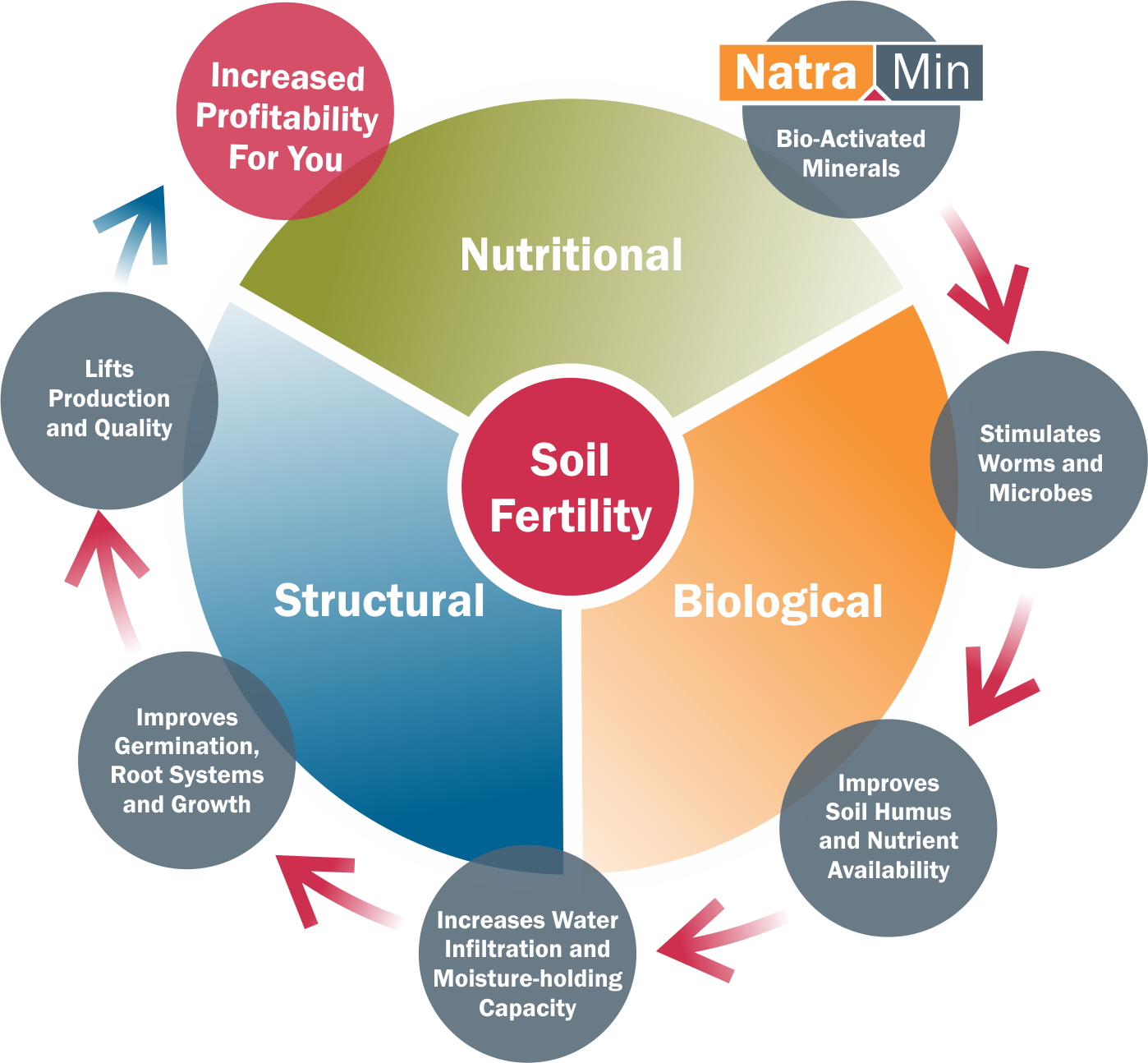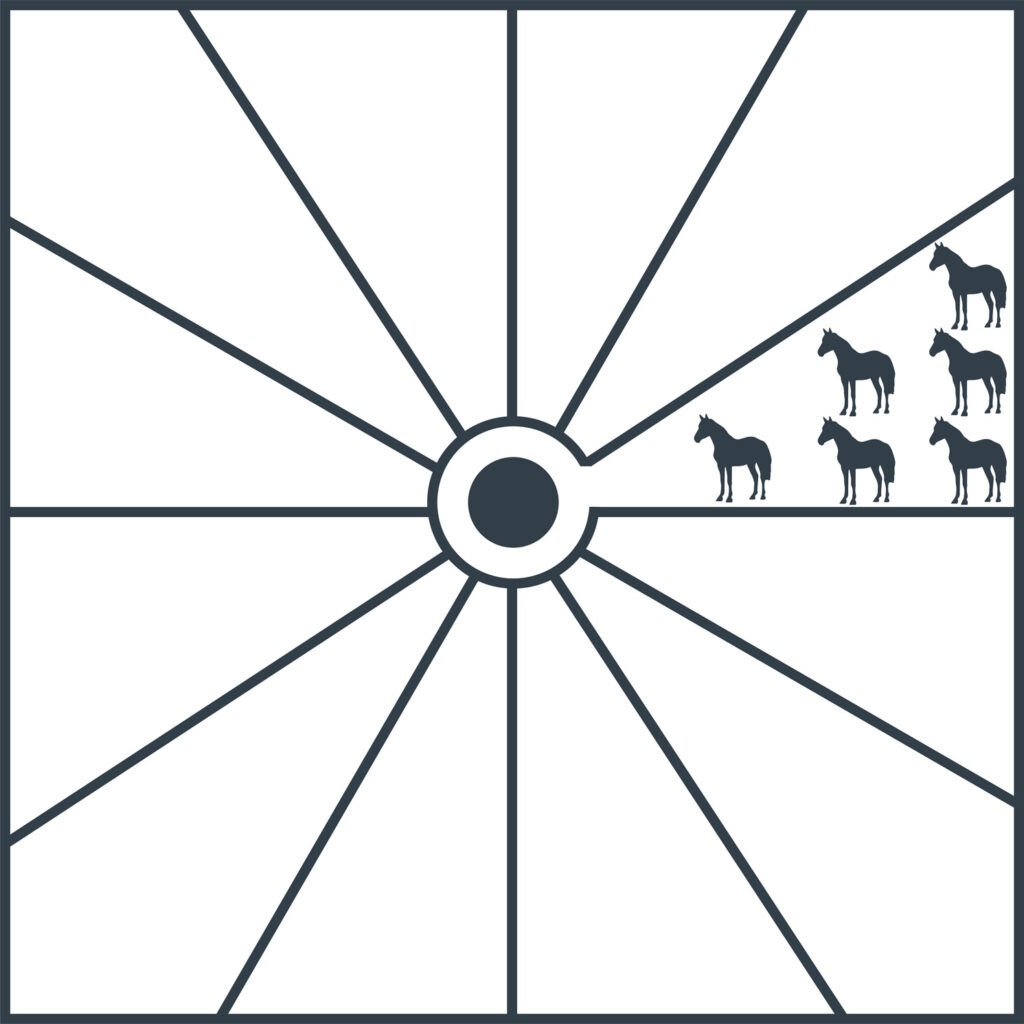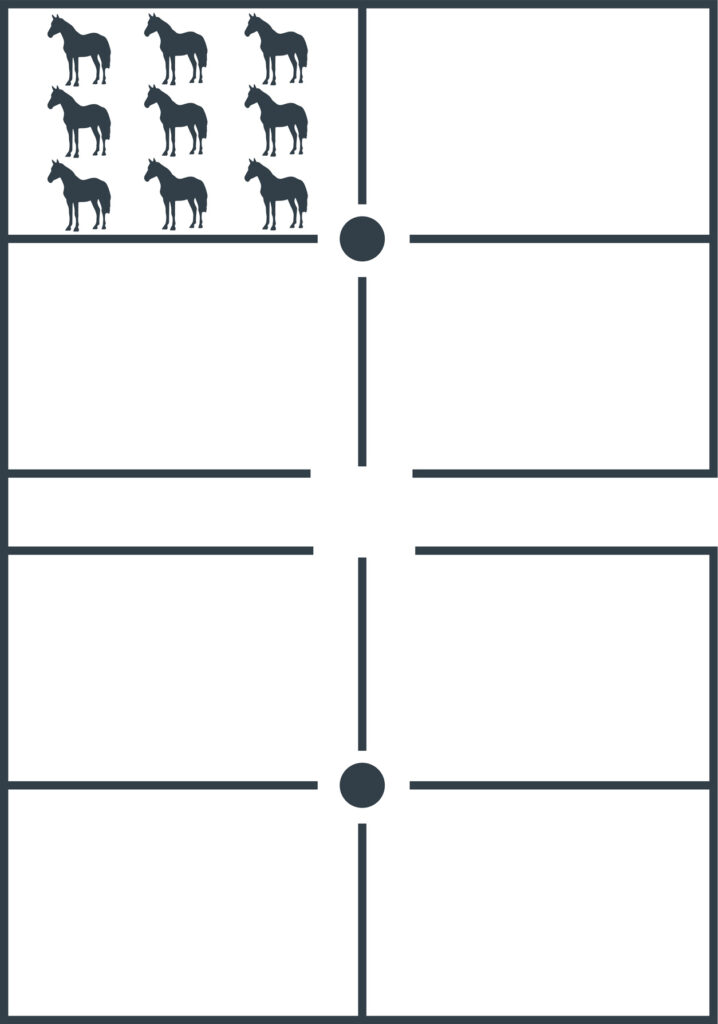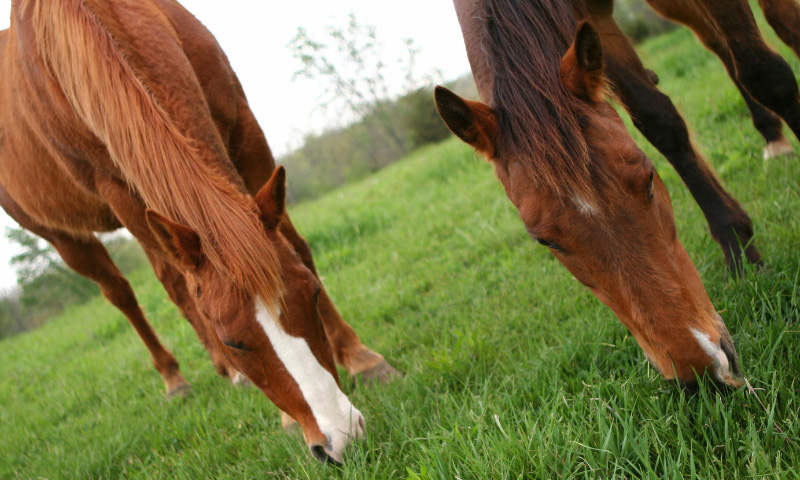Grazing horses attain benefit from both the nutritional value of the pasture and from the exercise derived from actively grazing. Horses at pasture are much less likely to suffer from behavioural idiosyncrasies that can occur when they are confined to a stable or yard for long periods of time.
Quality Paddock Feed Reduces Fodder Costs
A well-managed productive grass-legume pasture blend can provide:
- The nutritional requirements of most horses except for heavily worked or productive horses.
- A natural grazing environment that allows the horse to express its natural behaviour.
- Space for the horse to exercise at will.
- Considerable cost savings without the need to purchase large quantities of expensive concentrate feeds.
- A significant reduction in the occurrence of feeding problems compared with those that can be experienced by hand fed horses.
- Reduced demands on the management of individual animal nutrition.
- A decrease in the occurrence of typical behavioural problems that are associated with the confined horse.
There are challenges to achieving healthy pastures for horses such as soil erosion, compaction and severe soil mineral imbalances. The performance of your pastures and grazing horses depends on the condition of your soil.
Fertile soil is your greatest asset
A large proportion of the Australian horse population is owned and managed on small land holdings that face the risk of becoming seriously degraded by continuous grazing of horses. Many issues of “Horse Sick” pastures can be avoided or overcome by careful and skilled management of pastures and the grazing horse.
The following hints and tips have been provided to support you to improve soil fertility and pasture quality. While your budget may dictate to what level the following steps can be implemented, it is important to remember that these steps can assist to improve pasture and decrease the reliance on purchasing feed.
The 3 aspects of soil fertility

MINERALS:
NatraMin Mineral Fertiliser and Soil Conditioner provides a source of macro-minerals such as calcium, phosphorus, potassium and sulphur, as well as broad spectrum trace elements such as boron, zinc and copper.
BIOLOGICAL:
Microbe and worm activity is crucial for converting minerals and trace elements into plant available form and the bio-stimulant in NatraMin helps to ensure the bio-availability of its minerals, as well as releasing nutrient lock up in your soil.
STRUCTURAL:
NatraMin’s primary function is a soil conditioner to soften soils via reducing soil surface crusting and cloddy, sticky soil types. Soil microbes and worms in your soil convert organic matter into humus, providing a storehouse for moisture and crop nutrients. Good humus levels provide softer, more friable soil resulting in improved pasture that can better tolerate weather extremes such as hot, dry conditions and can assist drainage in wet weather.
NatraMin Mineral Fertiliser and Soil Conditioner
The range of NatraMin Mineral Fertilisers and Soil Conditioners are designed to assist soil regeneration by addressing the nutritional, biological and structural aspects of soil fertility. A major advantage of using NatraMin products for horse pastures is that they are made from natural rock minerals that have no withholding period so paddocks can be grazed immediately after spreading. When integrated with soil management strategies, NatraMin can assist to produce living, healthy and balanced soil capable of producing high yielding crops, pastures and healthy horses.
Apply NatraMin once or twice each year. It can be spread over existing pasture or applied to the soil prior to planting pasture. NatraMin may replace the need for lime and gypsum. Following are some guidelines to help improve soil fertility and pasture quality and decrease the reliance on purchasing expensive concentrate feeds:Soil Test to assess nutrient availability in the soil
Soil testing, with a complete mineral analysis is a relatively cheap and cost-effective way to determine which mineral problems if any need to be addressed through pasture management or dietary supplementation. One or more soil tests may be necessary, depending on the size of the property, variation in soil types and history of the paddocks. AgSolutions soil tests include an assessment of the levels of both macro and trace minerals in the soil, fertiliser recommendations for pasture as well as soil and pasture management guidelines.
How to address Soil Compaction
Soil compaction, particularly in high traffic areas, contributes to increased weeds and poor grass growth resulting in horse owners gradually having a higher dependance on purchased feed. The decline in the pasture means a reduction in your low cost on property feed resource, thus leading to a more expensive “substitution” feeding cost.
Soil aeration with a spiked aerator or Yeomans type plough is beneficial for hard setting soils. Aeration may be shallow and should be performed when moisture is optimal to reduce the soil disturbance (to prevent rough ground and possible injuries) and to avoid impacting existing pasture. Aeration increases water and oxygen infiltration of the soil while also allowing root systems of your pasture to go deeper into the soil.
The use of NatraMin can assist to stimulate microbe and worm activity in your soil, converting mulch into humus and creating more friable soil. While soil remineralisation with NatraMin can help to improve the nutritional level of your pasture, during winter and dry conditions the mineral content in your pasture may be lacking. Because soil minerals have been leached away over decades of farming, even purchased fodder may lack optimum nutrient levels.
Clinical and sub-clinical mineral deficiencies can restrict animal performance, health and fertility. With MegaMin Equine Enhancer, you can provide year round broad spectrum, natural minerals for your horses.
No horsing around when beefing up your pastures…
John Clothier, ‘Christmas Creek Pastoral’, Beaudesert, talks firsthand about his success in establishing high performance pastures.
“I have been using NatraMin for 6 years since I first purchased the property. The paddocks were bare as they had previously been night paddocks for dairy cows for many years. Improved pastures were planted and established well under a NatraMin program that focused on addressing not only soil nutrition but also the greater impact of soil structure (sticky, high Magnesium soil type). Pastures established well and the biggest improvement is that the soil no longer sets like concrete. The most important change to our program was the application of NatraMin Cal-S twice a year at 800kg/ha for the first two years and now a maintenance of 400kg/ha each year.”
Christmas Creek Pastoral runs beef cattle but the major business component is the horse spelling and agistment property for top quality Thoroughbred race horses.
“Clients often remark how well their horses are looking after being on this property for just 6 weeks. Our clients are from all over the eastern seaboard and expect good quality pastures for feed, while the presentation of the property and pastures is also paramount to my business. The real evidence of our success is the improved soil structure, pasture growth and density of grass in our day yards (something unheard of on many horse properties). Regular, relatively high rates of NatraMin are applied several times each year to the day yards to achieve this. AgSolutions have been able to assist me with my pasture management through their soil testing and NatraMin soil conditioners/fertilisers. Our forage program still involves other Nitrogen inputs and starter blends that we complement with grazing management, legumes and crop rotations.”
Property Plan and Grazing Management
Rotational grazing or strip grazing can provide a way to budget available pastures. If there is an opportunity to split paddocks up into smaller areas, this allows rest and recovery time for pasture and supports the regeneration of palatable species.
Strip grazing using electric fence (photo below) provides better utilisation of pasture. There are several considerations to be made when planning a cell grazing layout.
- Watering points can be an obstacle and may be dependent on whether permanent watering points such as creeks and dams are in use or troughs set up to service more paddocks.
- Providing close proximity for horses that are in daily work.
- Consider dividing flat ground and slopes into separate paddocks to enable flat areas to be rested during wet periods.
- Grouping horses together can be a challenge and may not be possible due to high value animals or stallions but the most beneficial component in grazing management is high density stocking for short periods of time.
Strip grazing has been successfully used with horses. It may be slightly more labour intensive as it involves moving electric fences regularly. Back fencing is essential to prevent horses grazing regrowth in recently grazed areas.
By following the strip grazing method, it is possible to rest and fertilise the paddock at some time during the season. This system will benefit horses nutritionally and allow control of intake to avoid obesity along with helping the paddock as there will be less bare land for weeds to germinate and the provision of conditions that allow various herbs to flourish.


The diagrams above offer possible layouts that provide centrally located water points.
Thoroughbreds benefit from better pastures and softer soils
Rod Jenner, Farming and Operations Manager of the renowned Glenlogan thoroughbred nursery at Innisplains, has seen the difference in soil structure and pasture nutrition since using NatraMin in their fertiliser program. Prior to 2010, their heavy black soils were becoming harder and pasture growth was below expectations. Like any thoroughbred operation, it’s always difficult to provide the opportunity for the soil and pasture to rest and recover. Poor soil structure was becoming an increasing problem and rain or irrigation took a long time to soak into the soil.
As Rod explained, “We are stocked heavily from June to January and the horses are back on the pasture almost immediately after watering, so the black soils cop a pounding.
We had heard about good results on other farms in the area which gave us the confidence to first apply NatraMin Cal-S in 2010. Our main challenge is that we can’t use synthetic fertilisers while the horses are in the paddocks so the biggest advantage for us with NatraMin is that it provides a safe option that can be grazed immediately after spreading.
NatraMin has improved our soil structure and is now a regular part of our fertiliser program. We apply it at the start of the season and it provides 90% of our fertiliser requirement. We then top dress with Nitrogen or Potassium during the growing season as required. NatraMin is safe as a fertiliser and because it has softened our soil, it is safer on our horses’ feet and legs because we no longer have to try to cultivate or rip paddocks. We have to be results driven in every part of our farming, pasture nutrition and breeding at Glenlogan and we have got more out of NatraMin than what we expected.”
Glenlogan conduct regular soil tests to assess progress and to check nutritional requirements. “We don’t use NatraMin every year on all of our paddocks. Because it is slow release, it can be applied up front well before planting and continues to work throughout the season.”
The improved pastures at Glenlogan still have horses back on them straight after irrigation but since using NatraMin, the soil is softer and water infiltration has improved to offset these impacts. As Rod concludes, “Rough ground affects bone development and we certainly don’t want the high risk of leg injury for young thoroughbreds with their racing life ahead of them. The soil structure continues to improve and the pastures are the best they’ve ever been.”
Pasture Establishment and Maintenance
Once you have worked out the most appropriate way to split paddocks for ease of management and based on terrain, soil types and watering points, soil tests can then be taken.
Choosing your pasture mix
Soil test results, soil types and locality will determine the most suitable pasture mix. It is vital to choose a mix of pasture species that has various depth root systems. Deep rooted plants bring up minerals that may have leached below the root system of shallow rooted plants.
For instance, Kikuyu, which is a very shallow rooted plant is known to be a very poor accumulator of calcium. To offset this, it is beneficial to include deep rooted legumes (clover and lucerne) and herbs such as chicory and tonic plantain, because they are known to be good accumulators of calcium and other minerals.
Preparation for planting
Steep paddocks may not be suited to ploughing and planting pasture due to the risk of erosion. In this case, pasture mixes may be oversown (more suited to legumes and herbs). Grass varieties tend to require “seed to soil” contact for successful establishment. It is an advantage to apply NatraMin 4 – 6 weeks prior to planting pasture. Because NatraMin assists to improve soil structure, many clients have reported reduced tillage costs and improved seed germination. When planting a new pasture (or forage) the paddock may need to be sprayed out or cultivated. The number of times the soil needs to be cultivated will depend on the soil type, structure and the variety of pasture or forage being planted.
Spraying paddocks involves using chemicals but if this is not desired, then cultivating the ground will assist to control some weeds. Avoid excessive cultivation as fine soil is more prone to erosion and when soil is over-worked there can be an increased loss of soil carbon. Ensure adequate seeding rates are used. A starter fertiliser is essential to maximise early growth to provide ground cover which will assist to suppress weeds. Cover crops (eg oats, barley, millet, rye grass) may be utilised to clean up paddocks, reduce weeds and increase the condition and fertility of the soil prior to planting a permanent pasture mix.
For native pastures or existing run down pasture there is the choice to improve and regenerate what is currently growing through grazing management and soil remineralisation with NatraMin, or alternatively, over sowing with a new pasture mix.
Management of newly planted pasture
For both new pasture and when renovating existing pasture, it is critical to allow time for pasture to establish itself. Nursing the pasture for the first 6-12 months may be necessary to ensure long term persistence and production. New pastures should not be grazed too soon. Test the plants by pulling them to see if grazing will pull the entire plant out of the ground. It may be best to only improve one part of the property at a time to ensure that new pasture is not grazed too early. New pastures should only be grazed for short periods and then rested. Mulching or slashing instead of ‘first grazing’ is desirable to encourage plants to establish their root systems and tiller out for maximum ground cover.
Mulching or slashing 1-2 times each year can help increase pasture density. Do not over fertilise pastures (however, adequate nutrition is important for establishment) as high levels of nitrates in a pasture are undesirable for horses. Horses overgrazing pasture to the ground due to a lack of area will create a number of issues. Set stocking is a major contributor in the decline of palatable pasture species, which eventually leads to more non-desirable pasture species and an increase in weeds. Successful nodulation of legumes provides natural nitrogen for other pasture species and reduces the need for nitrogen fertiliser.
Managing horses grazing Sub-Tropical and Tropical Pastures
Many of the sub-tropical grass species growing in Australia contain calcium as calcium oxalates which is insoluble in the high alkaline environment of the small intestine and consequently makes the calcium unavailable for absorption by the horse. This leads to a calcium deficiency and the condition known as Nutritional Secondary Hyperparathyroidism or more commonly referred to as “Big Head” in horses. High oxalate containing grasses are: Setaria, Buffel Grass, Kikuyu, Purple Pigeon Grass, Green Panic, Pangola Grass, Para Grass and Signal Grass.
Despite this constraint, horses are successfully grazed on these species with the oxalate problems being avoided by providing the horse with a daily calcium source. Where pastures contain predominately Buffel Grass and Setaria species, high rates of calcium supplementation may be necessary to ensure adequate calcium is available for uptake. Growing horses, aged horses and pregnant and lactating mares should receive a higher rate of calcium supplementation to meet their requirements.
Improving your pasture has many benefits including increasing the nutrients available to horses, improving the look of your property and possibly the value, while reducing the environmental issues such as erosion and weeds. For further information on MegaMin Bone Defender or pasture management contact AgSolutions on 1800815757.
Minerals for Horses
The horse has a single stomach (monogastric) digestive structure that is suited to foraging for long periods on grass dominant pasture. To maintain optimum health a horse requires a balanced diet receiving adequate levels of all nutrient classes on a daily basis. The major nutrients required are: Water, energy, protein, fat, fibre, minerals, electrolytes and vitamins.
Minerals play important roles in physiological, structural and regulatory functions within the horse’s body and without adequate levels a number of health issues may arise. A borderline deficiency of a trace mineral may be present in the diet without a horse showing any outward signs.
Pasture is an instrumental source of nutrients for horses but often it is too low in some crucial nutrients to meet the horses’ requirements. In most cases pasture can provide horses with plenty of digestible energy, protein, fibre, some minerals such as potassium, magnesium, iron, manganese and green pastures are especially rich in vitamins A, E, K and the B-group vitamins
Australian soils and consequently the pastures, hay and grain we feed horses tend to be deficient in a number of minerals. Analysis of feeds in Australia has indicated that the content of many minerals can vary between individual batches of feed. Feeds produced from plants or plant products grown in different areas may also vary widely in mineral content. Pastures usually lack adequate quantities of copper, zinc, selenium and iodine and have highly variable amounts of calcium, phosphorus, sodium and chloride. Consequently horses on pasture and hay based diets will often require a supplement to replace shortfalls of essential minerals.
To help provide a balanced diet for a horse it is a good idea to get a nutrient profile of the pasture and hay that it is eating via a pasture/hay test. To obtain accurate nutrient levels of pasture or hay it cannot be guessed by simply looking at the forage or comparing it with similar examples. AgSolutions are now offering hay and pasture testing services along with equine nutrition advice to support mineral supplementation in all classes of horses.
MegaMin Equine supplements are based on AgSolutions unique natural minerals that are broad spectrum and contain a host of trace minerals such as chromium, boron and silicon that are absent from many other supplements.
- Silicon is incorporated into joint cartilage and is essential for bone formation and collagen synthesis.
- Chromium is concerned with the control of blood glucose and has been reported in supporting increased energy metabolism, reduced stress and lactic acid accumulation during fast exercise.
- Boron is believed to be involved in mineral stasis and is also thought to play a role in normal brain function
In addition to livestock supplementation services AgSolutions provides soil and pasture nutrition support. Understanding soil and nutrient relationships that impact on nutrient uptake into the plant or pasture being grazed plus knowledge of soil structure and biology on this system is pivotal to successful pasture management. Our qualified field advisors can assist you with soil testing and pasture management programs from fully organic to fully conventional operations.
